Translation:
Original: State of Solana Q3 2023
Author: Peter Horton
Translator: 0xSekiro
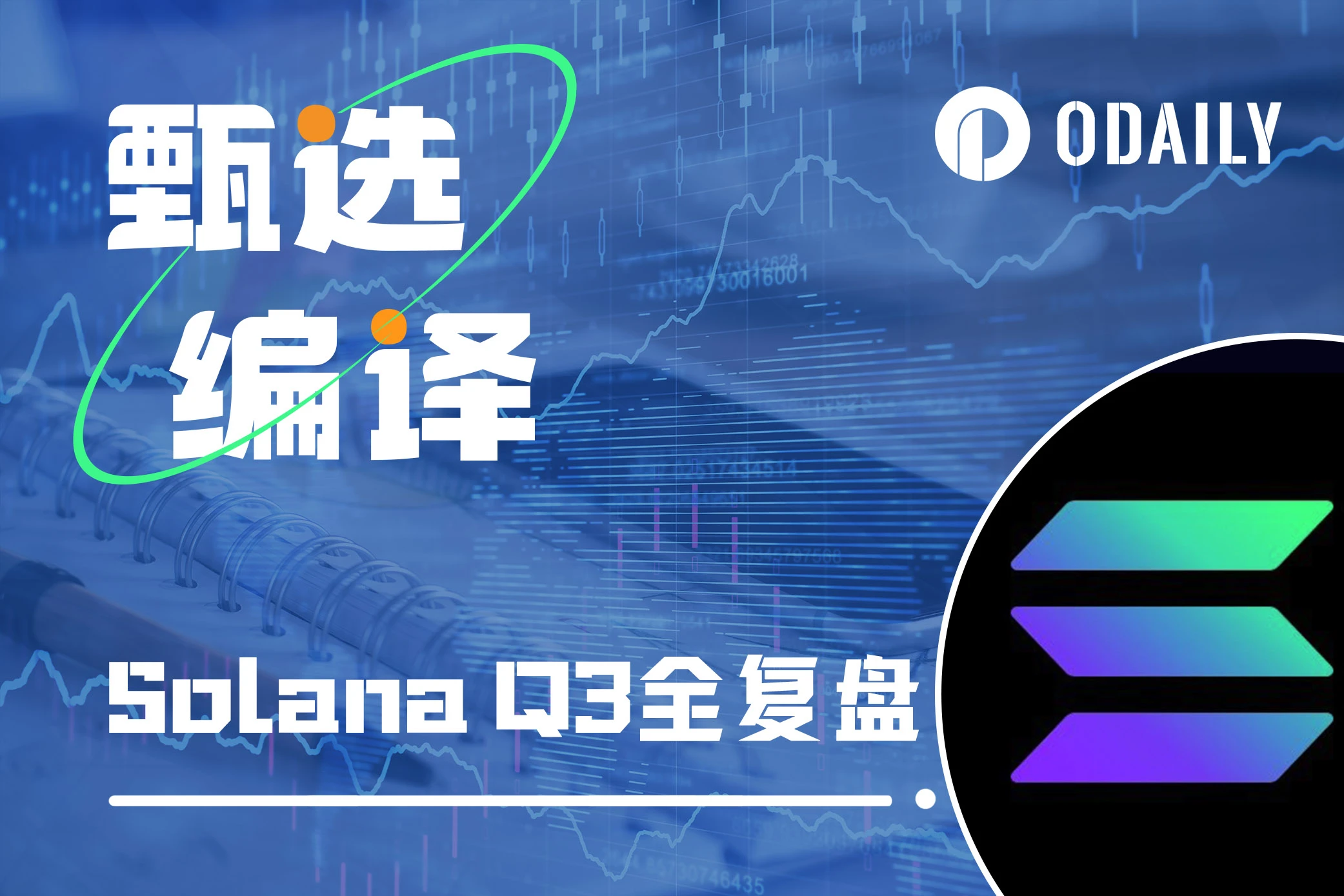
As an ecosystem closely related to FTX/SBF, Solana also suffered significant pressure and impact in the aftermath of the FTX incident. However, as time passed, while SBF remains entangled in legal disputes with former Alameda Research CEO Caroline Ellison, Solana seems to have emerged from the shadows and achieved new accomplishments. In this article, Peter Horton, a Layer 1 protocol analyst, provides a comprehensive analysis of what Solana has been up to in the past year, its current situation, as well as the future opportunities and potential, using detailed data and examples, as the first anniversary of the FTX "black swan" approaches. Perhaps through this article, we can also gain a more macroscopic and clear understanding of Solana.
The following is the original report, translated by Odaily Planet Daily.
Key Points
In Q3 of this year, the minting volume of compressed NFTs (cNFT) reached nearly 45 million, a 316% increase compared to the previous quarter. Free collectible distributor DRiP accounted for 87.5% of this, followed by Dialect and Helium.
Solana's Solana Virtual Machine (SVM) and technical stack are attracting attention and adoption from external parties. For example, in the third quarter of this year, MakerDAO founder Rune Christensen published an article in the community titled "Exploring Solana Codebase Forks for NewChain"; Eclipse announced a Layer 2 mainnet architecture supported by SVM; and Visa integrated payments on Solana.
Solana's total locked value in DeFi increased by 32% quarter-on-quarter, reaching $368 million. This growth was driven by point systems introduced by DeFi and liquidity staking protocols, with MarginFi, Jito, Cypher, and BlazeStake being the main contributors.
The V1.16 upgrade reached a supermajority stake by the end of the quarter. This upgrade reduced the memory requirements for validation nodes, introduced features and capabilities required for confidential transfers, and improved support for zk-proof.
Despite concerns about FTX potentially liquidating its over 57 million SOL tokens, SOL's market value still increased by 17% quarter-on-quarter, reaching $8.4 billion. FTX/Alameda's SOL tokens are subject to various unlocking schedules, with the average unlocking date in the fourth quarter of 2025.
Introduction to Solana
Solana is an integrated open-source blockchain designed to synchronize global information with high efficiency and speed. Solana optimizes latency and throughput through various features, sacrificing some verifiability. It achieves this goal through features such as its novel timestamp mechanism called Proof-of-History (PoH), block propagation protocol Turbine, and parallel transaction processing. Since its mainnet launch in March 2020, through several network upgrades, Solana has further improved network performance and resilience, including QUIC, stake-weighted Quality of Service (QoS), and on-chain fee markets.
The Solana Foundation, Solana Labs, as well as third-party teams such as Helius and Superteam, have further promoted the development and growth of the Solana network and ecosystem. Currently, Solana Labs has raised over $335 million in private and public token sales, and its ecosystem covers projects in many areas, including DeFi, consumer, DePIN, payments, and privacy.
Key Metrics
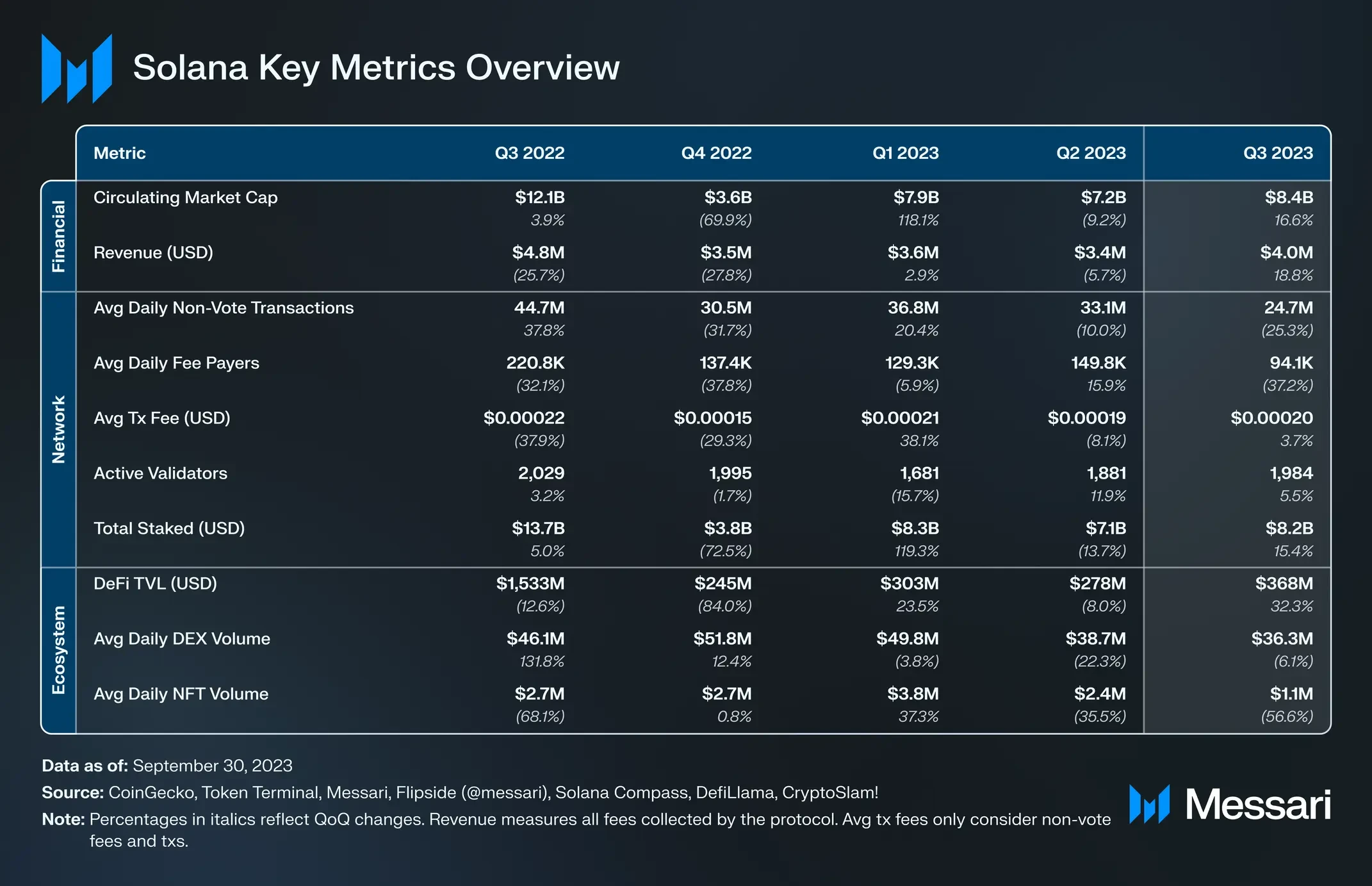
Financial Analysis
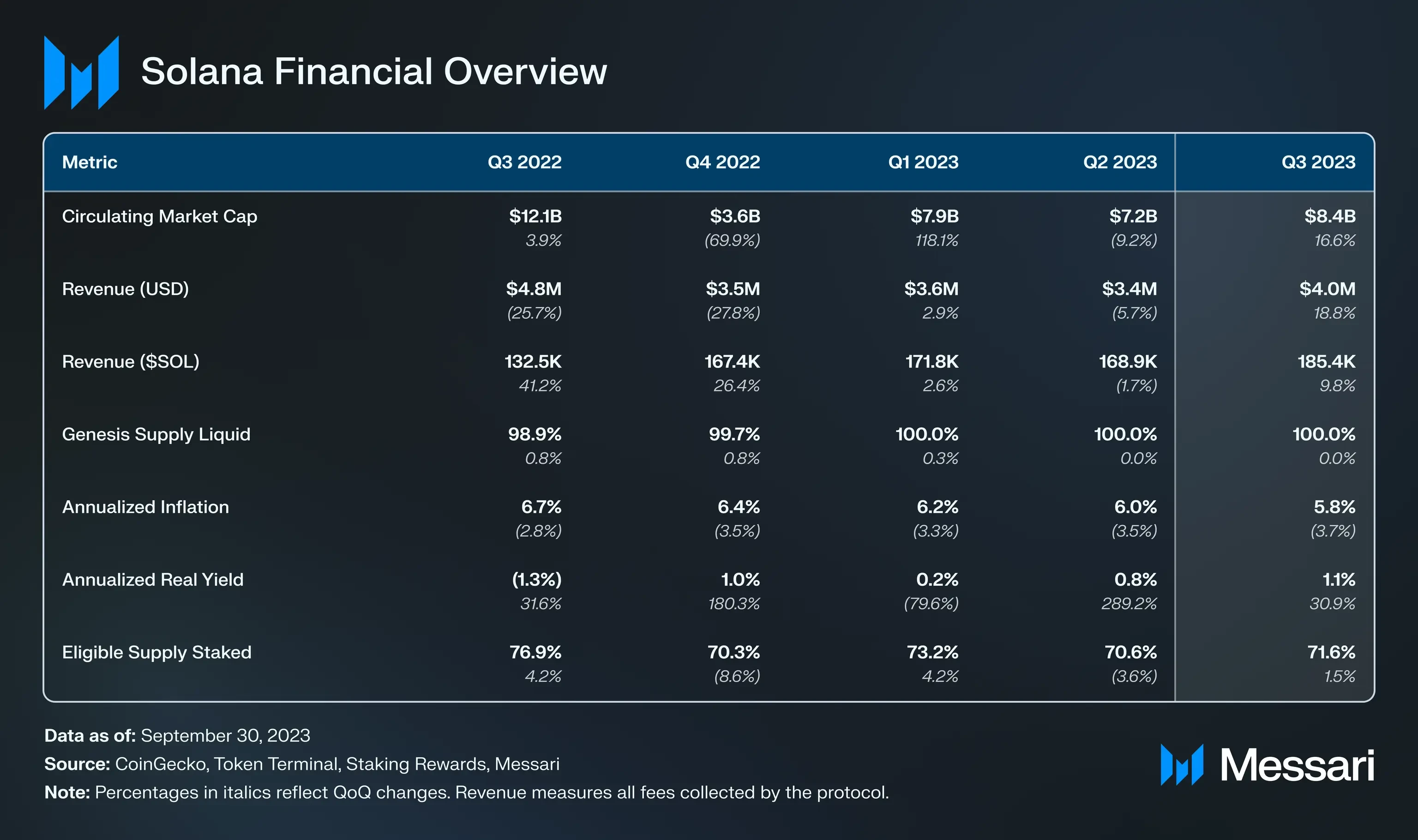
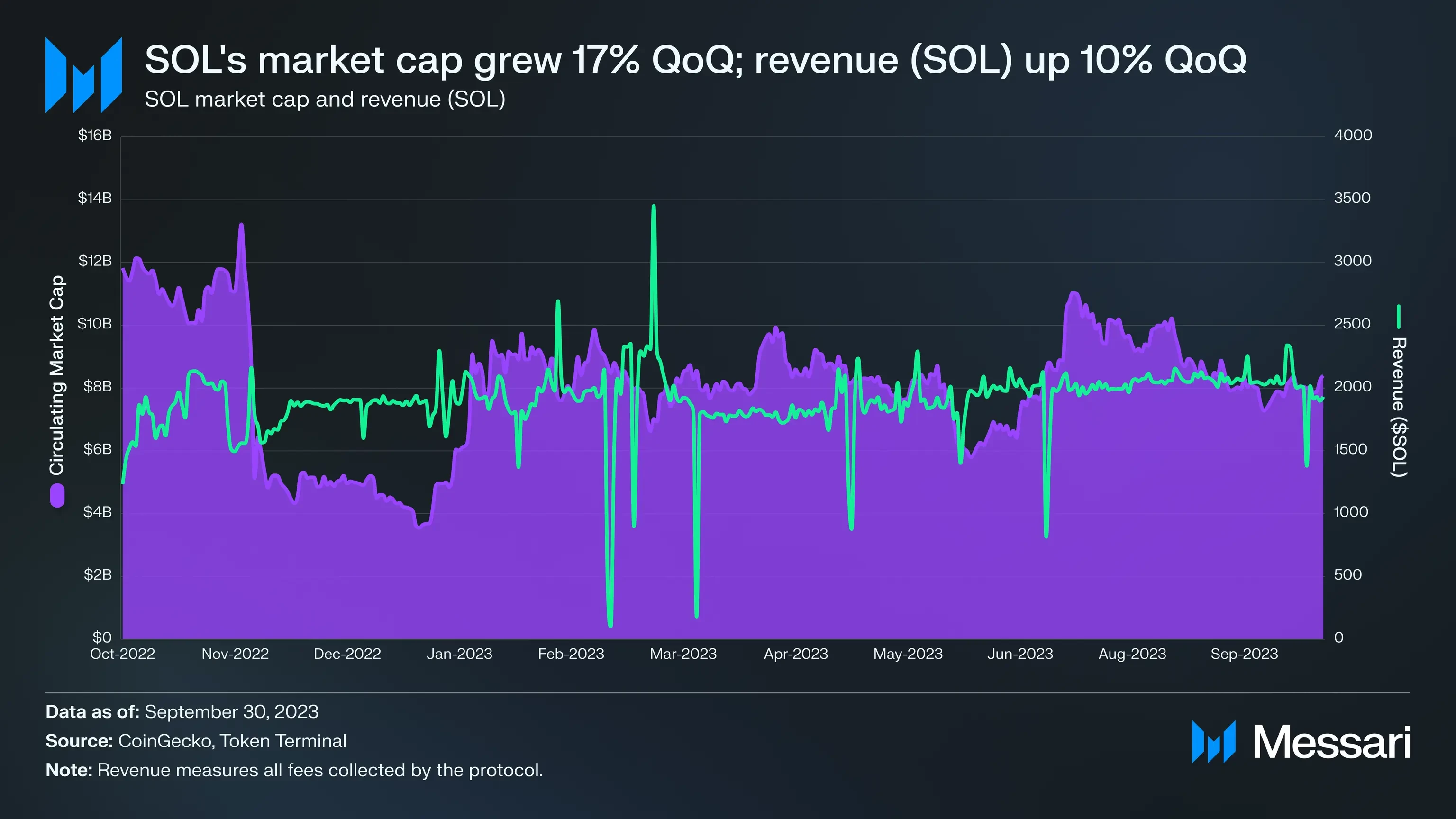
In early June, the SEC filed regulatory complaints against Coinbase and Binance, identifying assets such as SOL as securities. These complaints led to a 34% decline in SOL's price. However, compared to other tokens identified as securities at the end of the second quarter, SOL's performance was stronger, and this momentum continued into the third quarter. Possibly due to the potential liquidation risk of SOL by FTX/Alameda (detailed below), SOL experienced a brief decline, but by the end of the third quarter, SOL's market value still reached $8.4 billion, a 17% increase quarter-on-quarter. It is worth noting that due to SOL's strong performance among assets of similar market value, its market value ranking rose from tenth place in Q2 to seventh place.
In dollar terms, Solana protocol fee revenue increased by 19% to $4 million, and when calculated in SOL terms, it increased by 10% to 185,400 tokens. In Solana's system, half of the protocol fees will be burned, and the other half will be distributed to block producers. Currently, the burned tokens have not significantly reduced inflation. Strictly measuring the new token issuance based on validator rewards, without considering other unlocking situations, the inflation rate at the end of the quarter was 5.8%.
Currently, Solana's inflation rate will continue to decrease by 15% per epoch until it stabilizes at 1.5%. At the time of writing, 71.6% of the total staked SOL is being staked to avoid dilution from new token unlocks. It should be noted that although the SOL held by Solana Labs or the Foundation is in an unlock state, it has not all been included in the circulating supply. Considering the unstaked tokens and the nominal yield higher than the inflation rate, the actual annualized yield of SOL was slightly positive at the end of the quarter, at 1.1%, a 31% increase quarter-on-quarter.
While initially unlocked SOL is liquid, behaviors such as grants or token purchases with "re-lock" properties also bring inflationary pressure. It should be noted that FTX/Alameda previously purchased over 57 million SOL tokens from the Solana Foundation and Solana Labs, and these tokens are subject to various unlocking schedules, allowing for over-the-counter trading, with unlocking dates in Q4 of 2025. Currently, FTX has been granted permission to liquidate its crypto assets in a pre-trial hearing on September 13. Therefore, prior to the hearing, SOL experienced negative price fluctuations, especially in the derivatives market, with a significant increase in short position options and funding rates approaching yearly highs.
Network Analysis
Usage Data
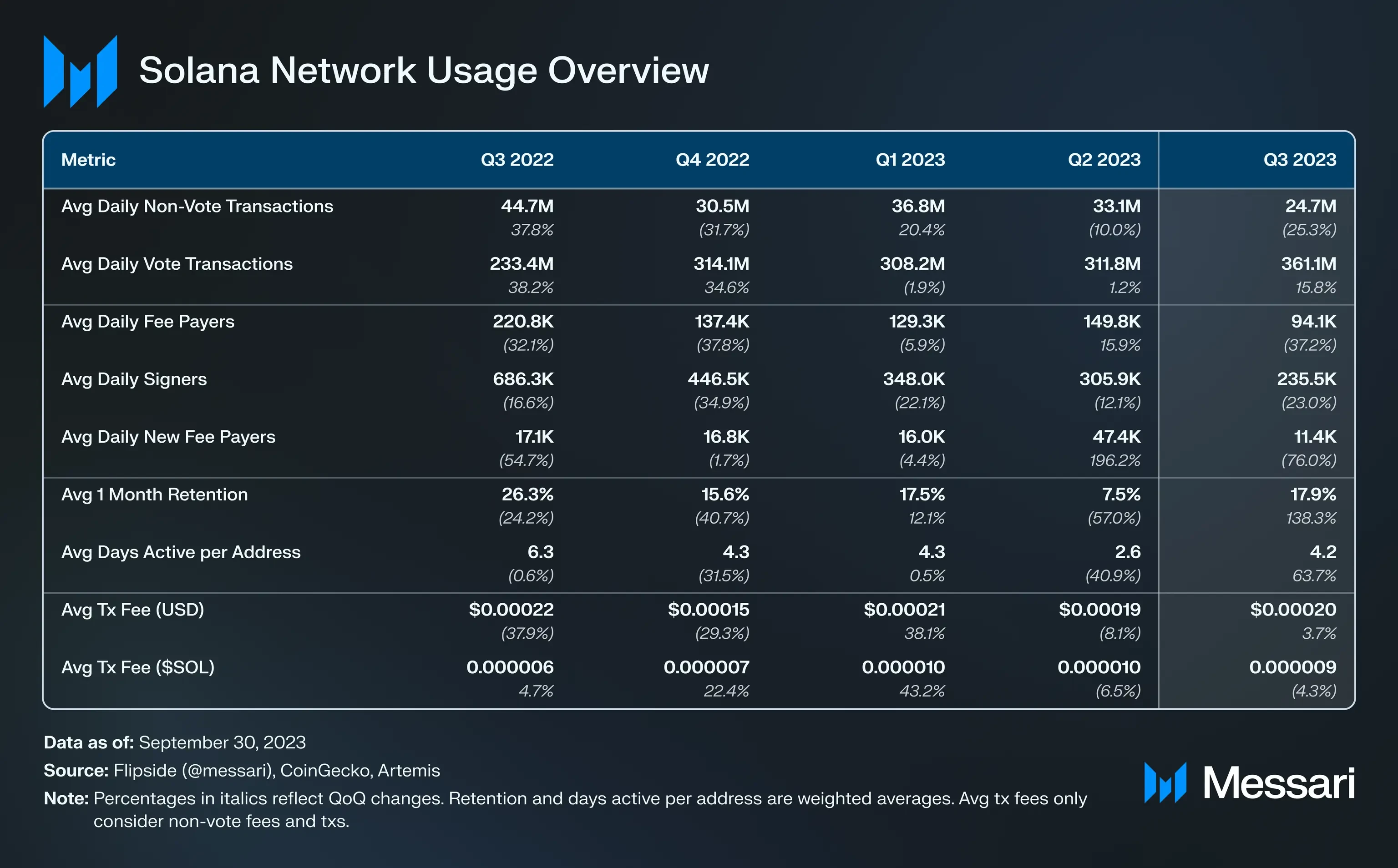
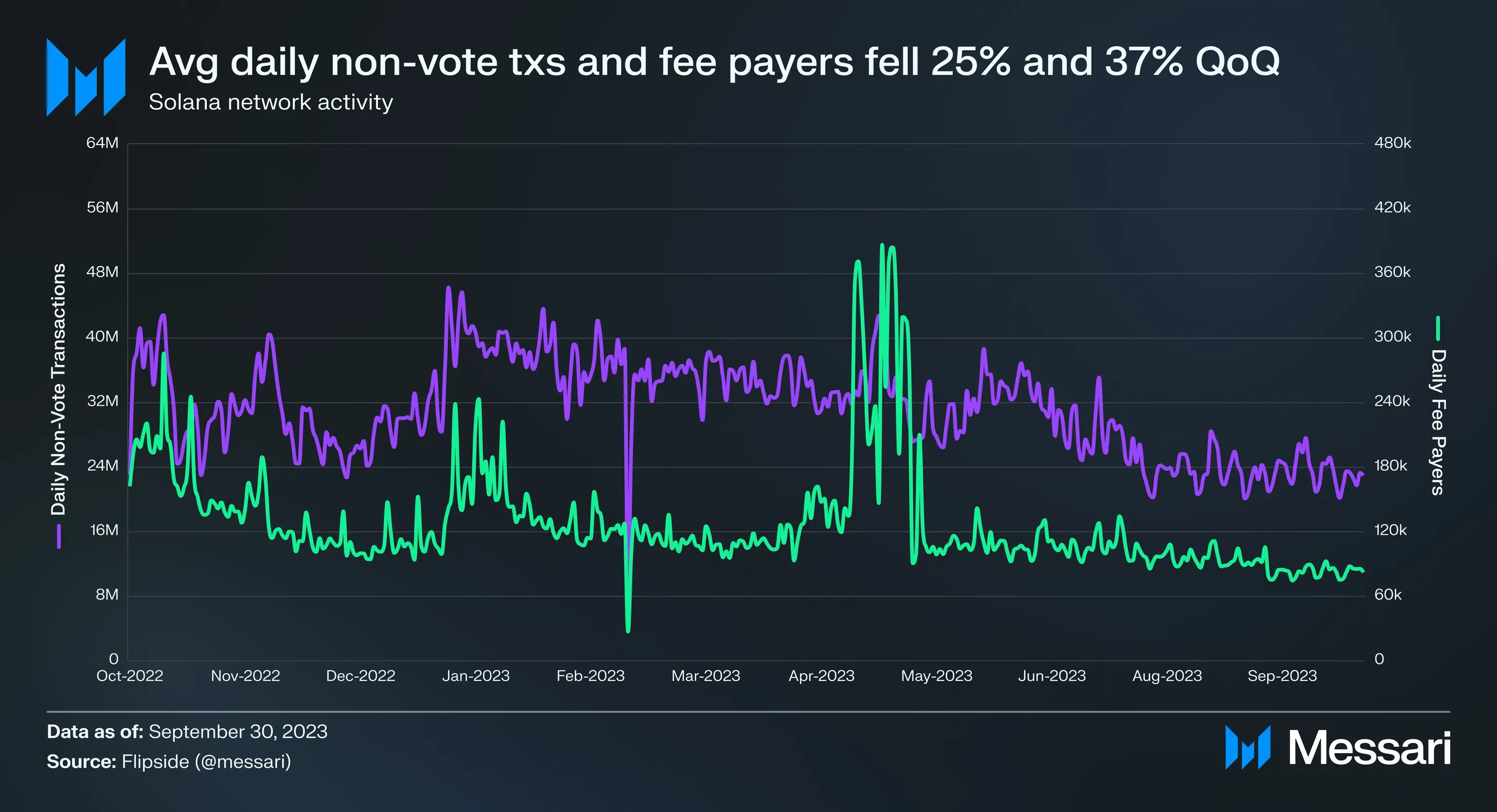
Ecosystem Activity
The ecosystem activity, measured by the number of non-voting transactions and unique payers, declined quarter-on-quarter and reached its lowest level of the year (excluding the network outage on February 25, 2023). The average daily non-voting transaction volume decreased by 25% quarter-on-quarter to 24.7 million, while the average daily unique payers decreased by 37% to 94,100. The user count is underestimated due to ecosystem projects subsidizing user gas fees. In fact, the average daily number of signers also decreased to 235,500, a 23% decrease quarter-on-quarter.
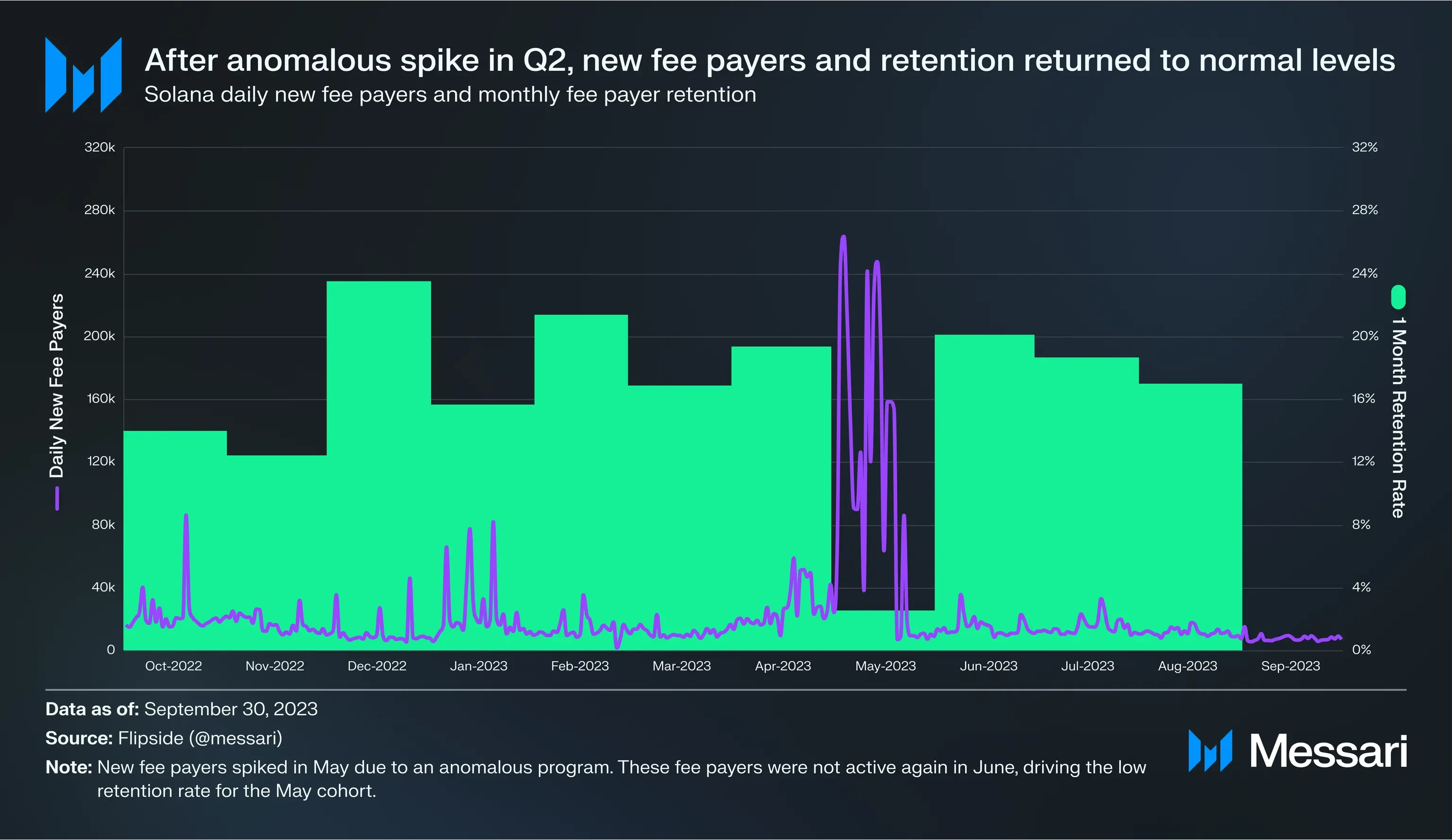
The average daily new payer count saw a more significant quarter-on-quarter decrease, with a steep 76% decline to 11,400. The sudden spike in Q2 numbers was due to abnormal activity from an unknown project, which created many new addresses in mid-May, but these new addresses were no longer active by June, resulting in a retention rate of only 2.5% for new users in May, far below the average monthly retention rate of 17.9% in Q3.
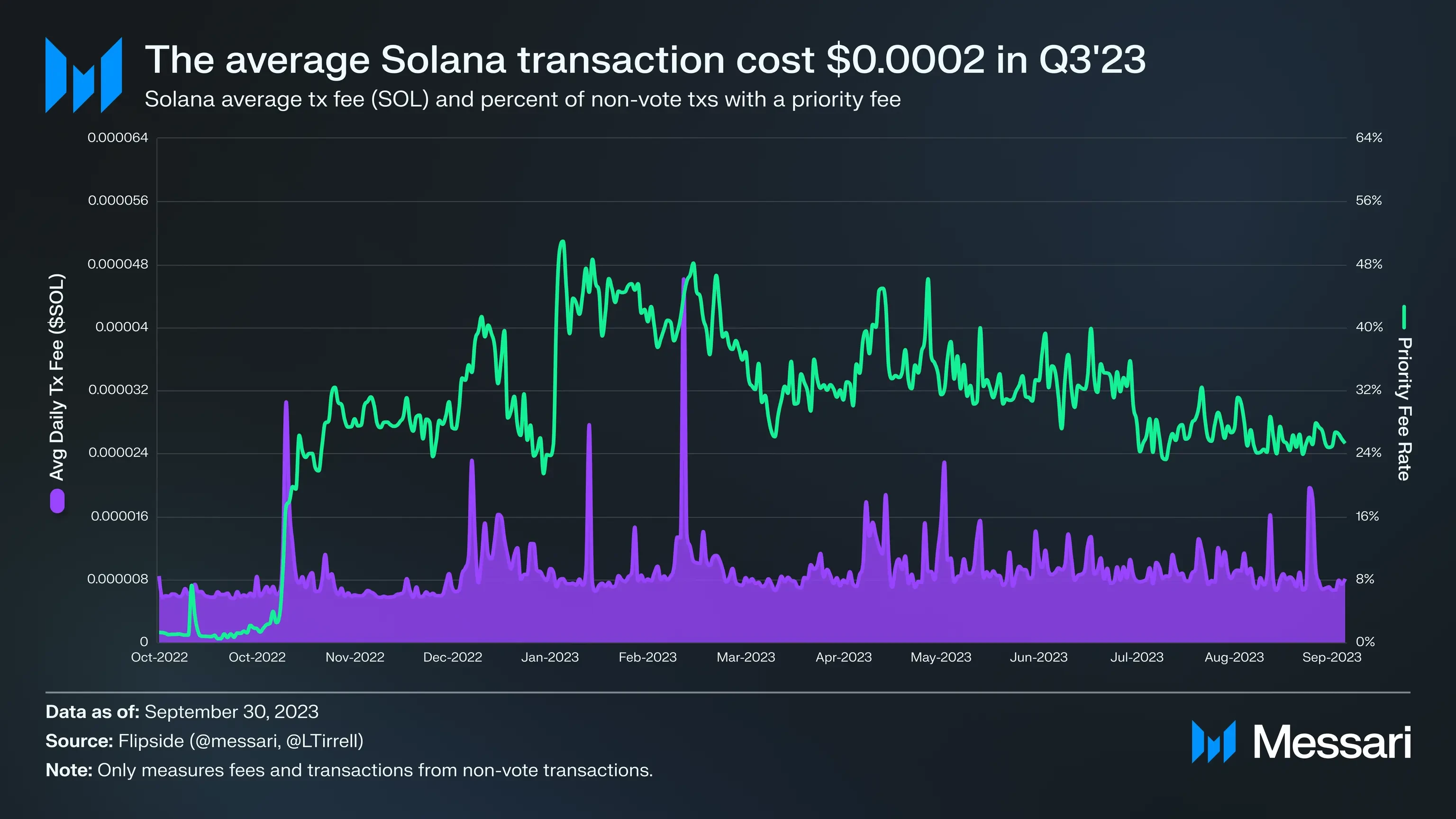
Solana's transaction fees continue to be one of the most stable and affordable ecosystems. The average fee for non-voting transactions in Q3 was $0.0002. Priority fees help reduce network spam and synchronize with the on-chain fee market to prevent network congestion. However, the proportion of non-voting transactions with priority fees has gradually decreased since many wallets and apps integrated this feature in the first quarter of 2023.
Security and Decentralization
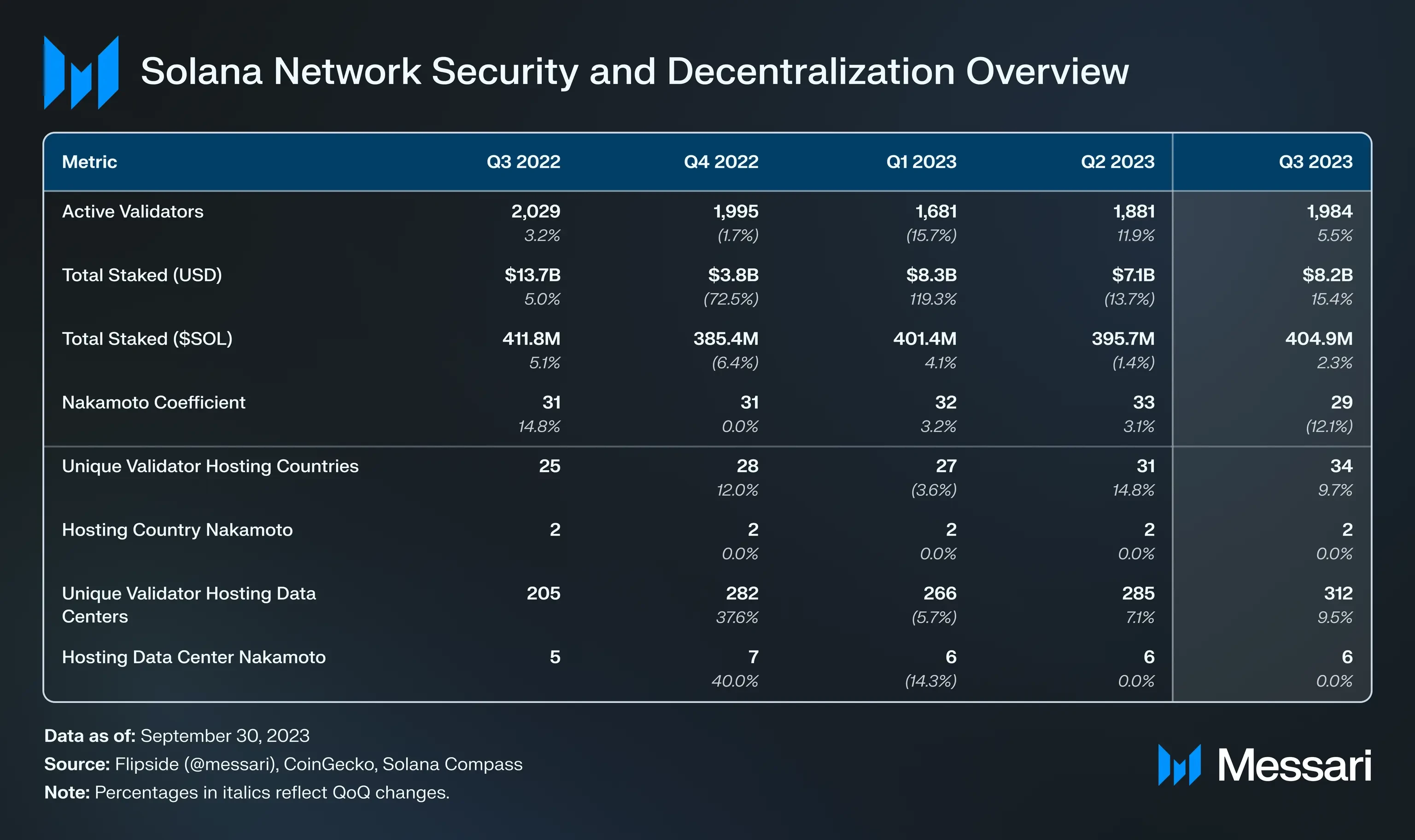
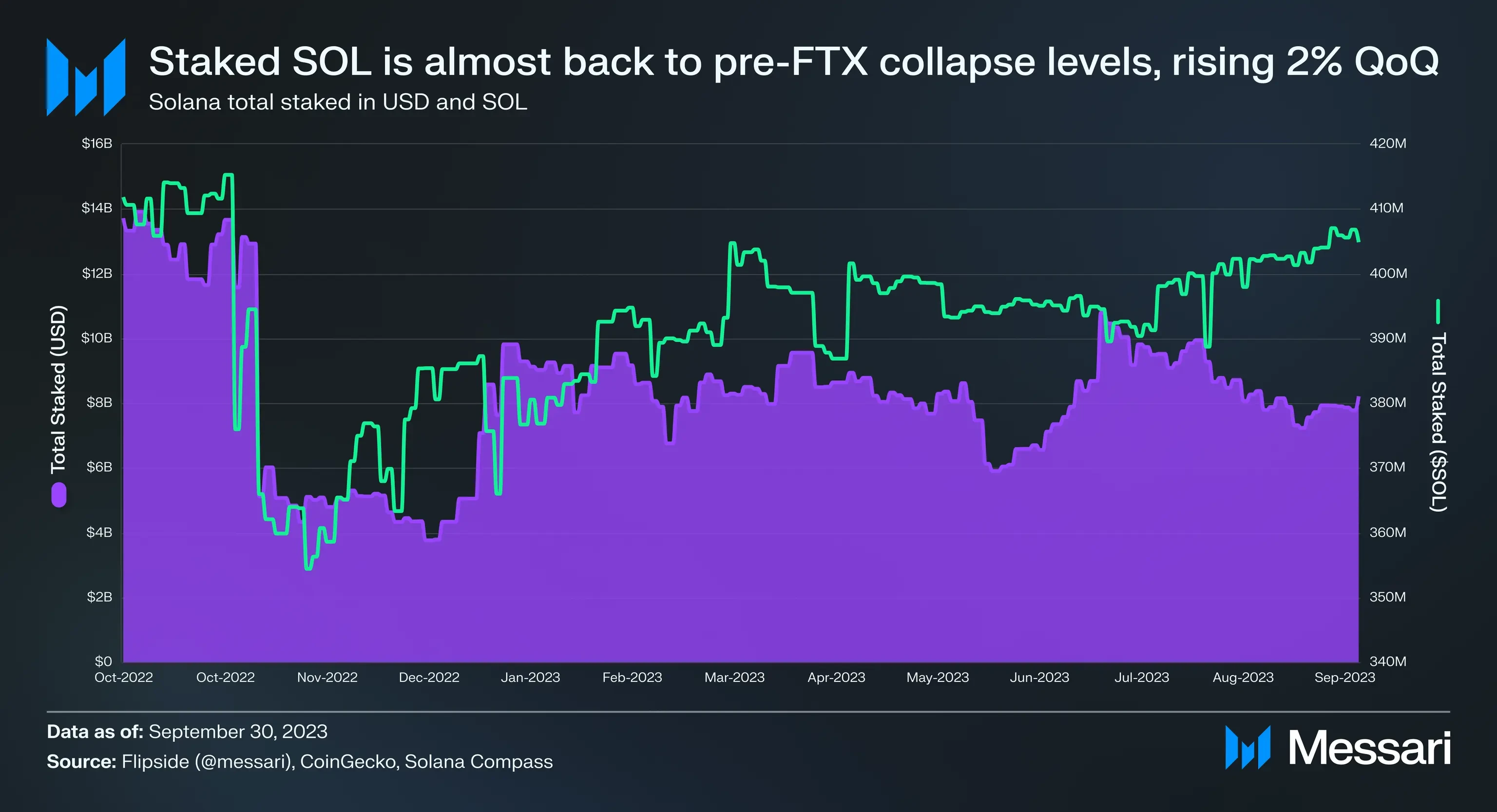
The total staked amount of SOL continued to rise in this quarter, increasing by 2% to reach 404.9 million, returning to the level before the FTX incident. Based on a market value of $82 billion (SOL's current price is $23.68), Solana ranks second in total staked market value, second only to ETH.
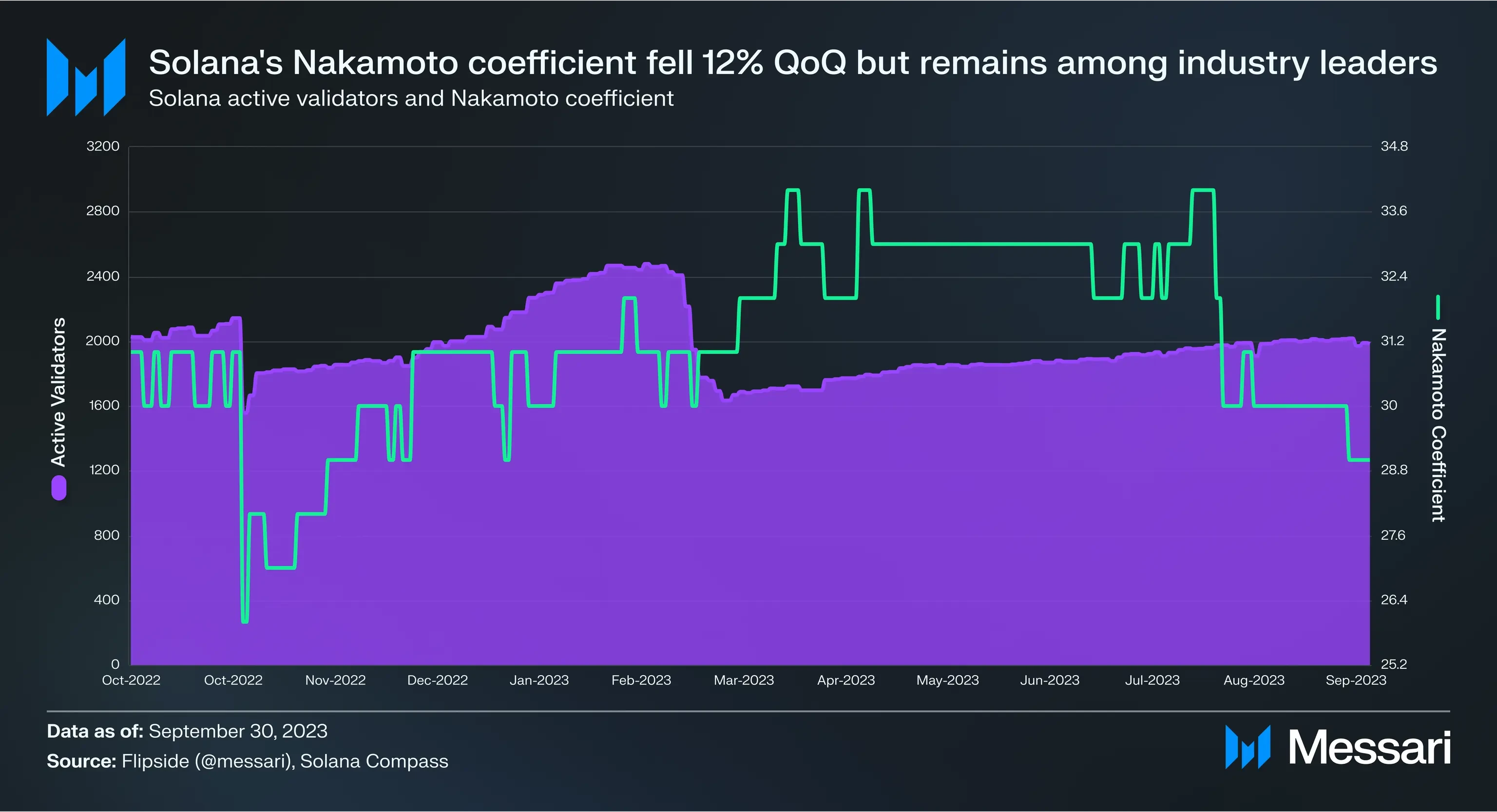
Solana's Nakamoto coefficient, used to quantify the degree of decentralization of various blockchains, decreased by 12% quarter-on-quarter to 29, still maintaining a leading position in the industry. The number of validators slightly increased, rising by 5.5% to 1,984. In Solana's October validator report, the Solana Foundation plans to make changes to the validator delegation program to encourage higher node quality rather than quantity. Currently, there are over 73 million SOL in the delegation program.
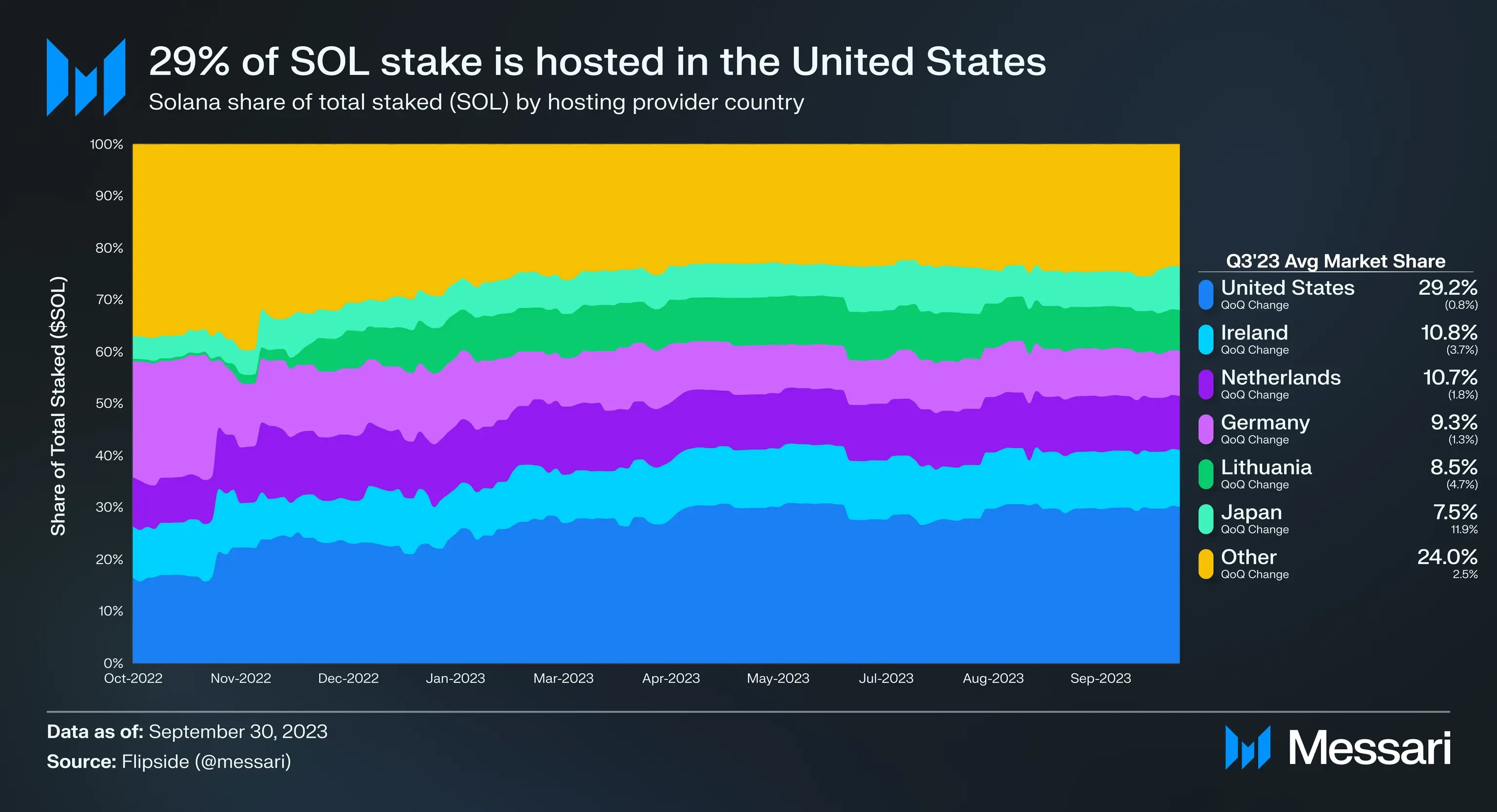
The Nakamoto coefficient is the minimum number of nodes required to stop network/interruption activity. In addition to checking on all nodes, it can also be measured through other dimensions crucial to the resilience of the validator network, including equity distribution by location, hosting providers, and client distribution.
Currently, Solana has validators in 34 countries, a 10% quarter-on-quarter increase and a 27% year-on-year increase. The United States holds the leading position in the Solana ecosystem, with a 29% share of all equity. With the U.S. share approaching the 33.3% threshold, Solana's geographical Nakamoto coefficient is 2. The Solana Foundation noted in the recent validator report that it plans to address the issue of the increased U.S. share over the past year.
Solana's validators are hosted in 312 unique data centers, a 10% quarter-on-quarter increase and a 34% year-on-year increase. Solana's data center Nakamoto coefficient is 6.
As stated in the validator report, Solana's hosting provider Nakamoto coefficient is 3, consisting of TeraSwitch, AWS, and OVH.
Currently, Solana has two clients: the original Solana Labs client and Jito Labs' MEV-optimized branch. Shortly after the end of the quarter, the share of the Jito client exceeded one-third. However, it does not have the same client diversity as clients written from scratch. Therefore, there are currently two clients being written from scratch: Firedancer and Sig.
Jump Crypto is developing Firedancer using C++. Considering the engineers' schedule, Toly recently estimated that Firedancer will be launched on the testnet by the end of this year and on the mainnet about six months later. In addition to client diversity, Firedancer may bring performance improvements. It maintained a throughput of over 1 million TPS in a test environment, while the throughput of the Solana Labs client in a similar environment is about 55,000 TPS.
Sig is a new client announced at the end of July this year, led by Syndica and written in Zig. Sig optimizes RPC reads to reduce Solana's slot lag. It also focuses on readability and conciseness, aiming to be more understandable for developers.
The lightweight client TinyDancer is also actively being developed. TinyDancer aims to increase the network's trustworthiness by allowing users to verify the state without running a full node themselves.
Finally, although difficult to measure, the Solana Foundation noted a significant increase in the participation of the validator network. Examples of its efforts include community-led validator dialogues starting in March 2023 and the Block Zero conference for Solana validators during the fourth quarter.
Performance, Upgrades, and Roadmap
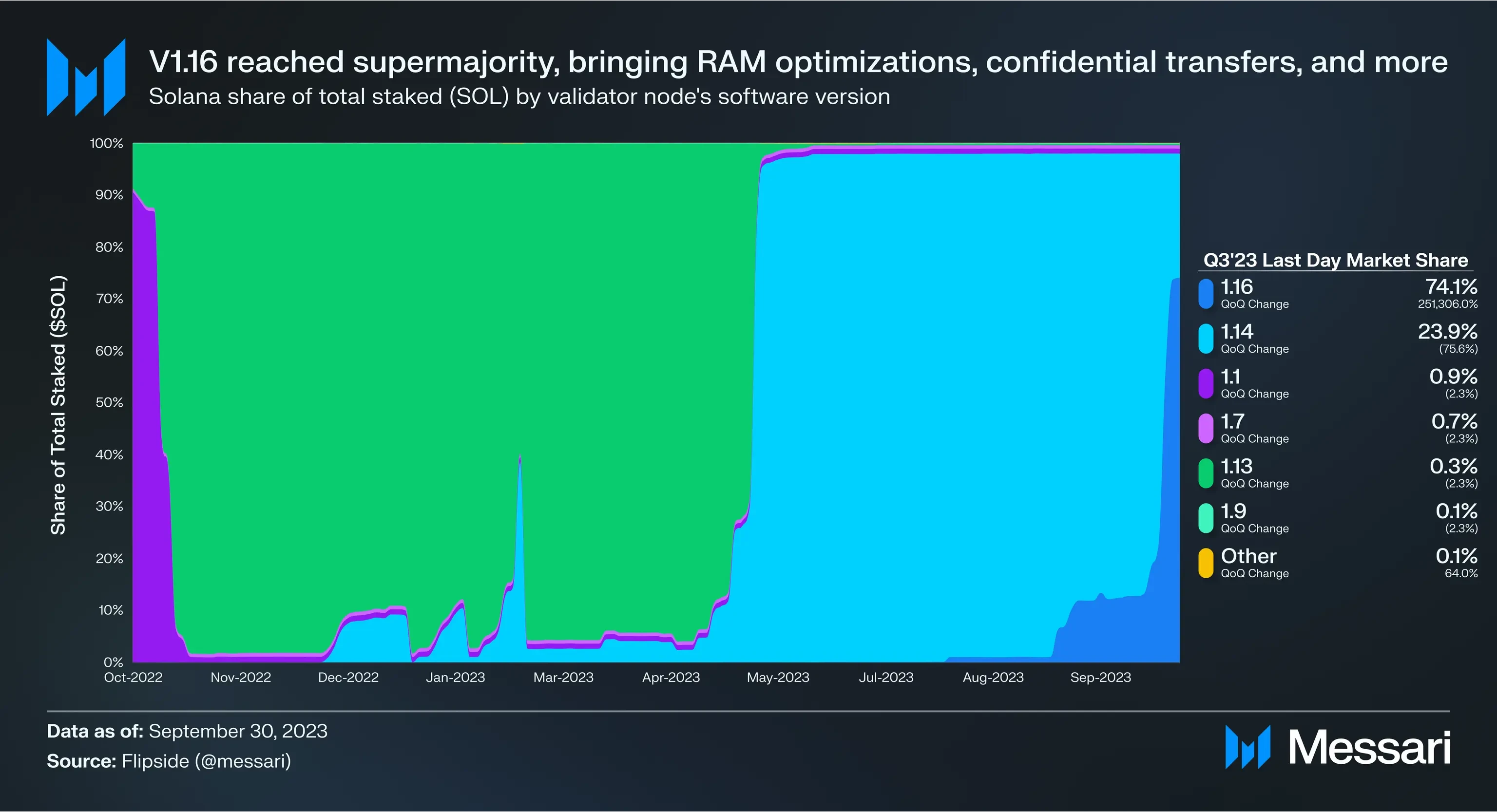
Validators began switching to the V1.16 upgrade at the end of August this year. Despite some minor errors, they were resolved with the help of the community. Starting from Epoch 510 on September 28, the vast majority of validators began operating the new software. Validators noticed a significant decrease in memory usage after the upgrade. In addition to RAM optimization, other new features in V1.16 include:
Support for SPL Token22 confidential transfers. Confidential transfers use zero-knowledge (zk) proofs to encrypt the balances and transaction amounts of SPL transfers. Users can provide read access to other accounts, achieving confidentiality while ensuring auditability. Confidential transfers will be enabled on the mainnet test version by the end of 2023.
Improved efficiency of validating zk proofs and support for 128 elliptic curve operations (equivalent to EIPs 196-198).
For more information about the V1.16 upgrade process and features, please refer to this Helius article.
It is expected that V1.17 will be launched in the early first quarter of 2024, bringing more support for zk and possibly including Poseidon system (a log retrieval tool).
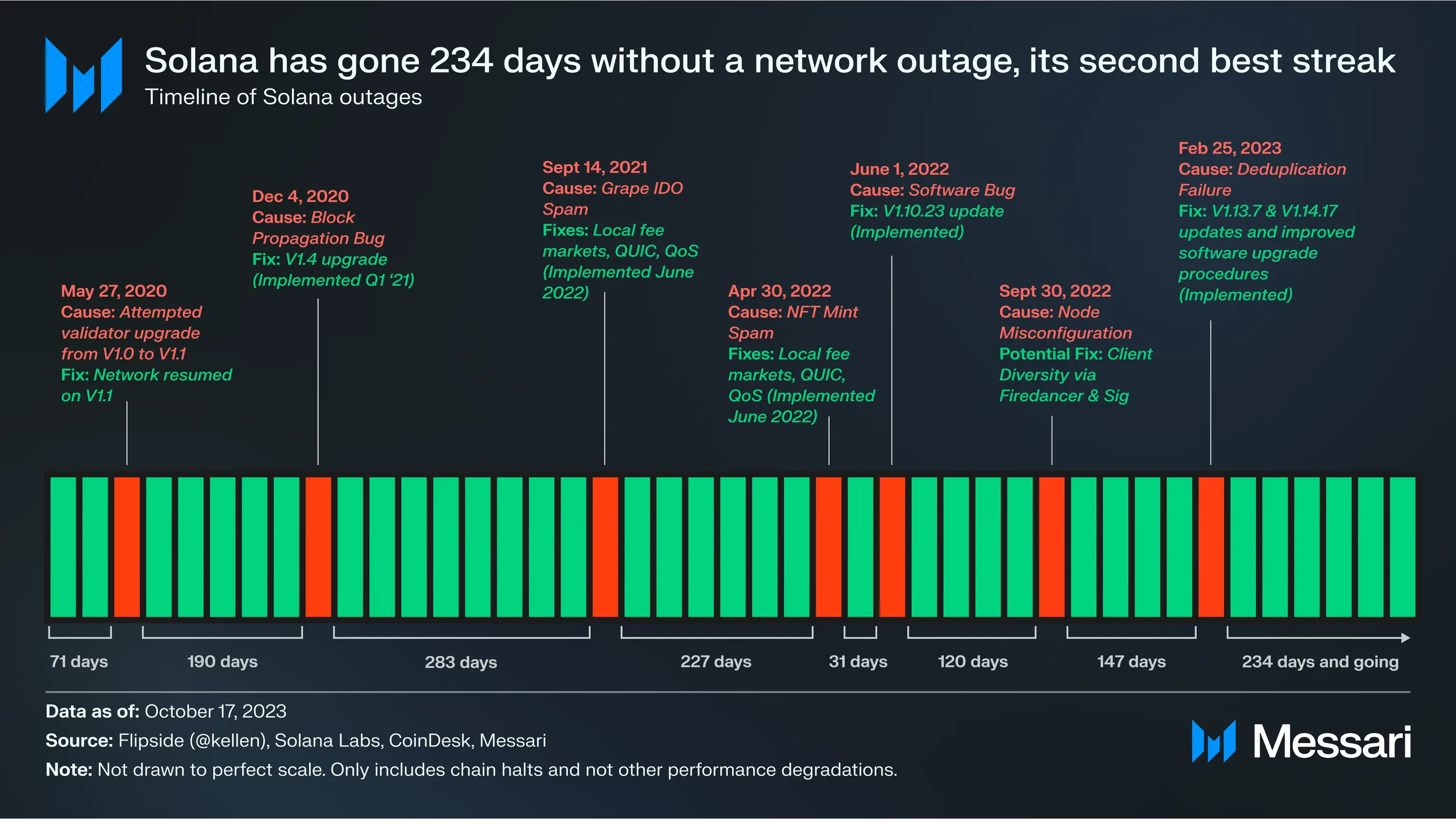
The Solana ecosystem is approaching its longest continuous online time since the outage on February 25, 2023. This achievement is the result of improvements in the upgrade process and new technological features over the past year, such as QUIC, stake-weighted QoS, and on-chain fee market.
The strong performance of SVM and the overall Solana tech stack has attracted external attention. The adoption of SVM outside of Solana includes:
MakerDAO: In the third quarter, MakerDAO founder Rune proposed using SVM forks as the backend engine for the Maker protocol and its sub-DAOs. Rune pointed out that after extensive research, he determined that Solana is the most promising codebase, citing reasons such as:
Technical quality (optimized integrated blockchain)
Multiple client implementations
Strong ecosystem and thriving developer community
Fork history used for applications like Pyth
Any measures are far from being completed. Therefore, despite MakerDAO deciding to adopt a different solution, Rune's post also demonstrated the technical quality of Solana and its open-source nature.
Eclipse: Eclipse was initially a Rollup that provided SVM as an execution environment. In mid-September, it announced a transition to a general Layer 2 powered by SVM. While some tried to view this as a victory for Ethereum at the expense of Solana, many members of the Solana community celebrated this announcement.
Rome: Rome Protocol, which utilizes Solana's shared sequencer, was launched at the end of the quarter. The shared sequencer network will be deployed as smart contracts on Solana, with each Rollup using its own Neon EVM deployment.
Neon EVM is an EVM engine deployed on Solana. Its mainnet went live in mid-July. The network averages about 22,000 transactions per day, with over 80% of total transactions coming from its surge activity. Upon its launch, Neon received some criticism from Solana community members due to its tokenomics model.
Two days after Neon's launch, Solana Labs released the Hyperledger Solang compiler, allowing developers to write Solana programs in Solidity. In comparison to Neon's ability to allow developers to write EVM contracts to run in the Solana ecosystem, Hyperledger Solang does not support Rust or C languages.
Ecosystem Analysis

DeFi
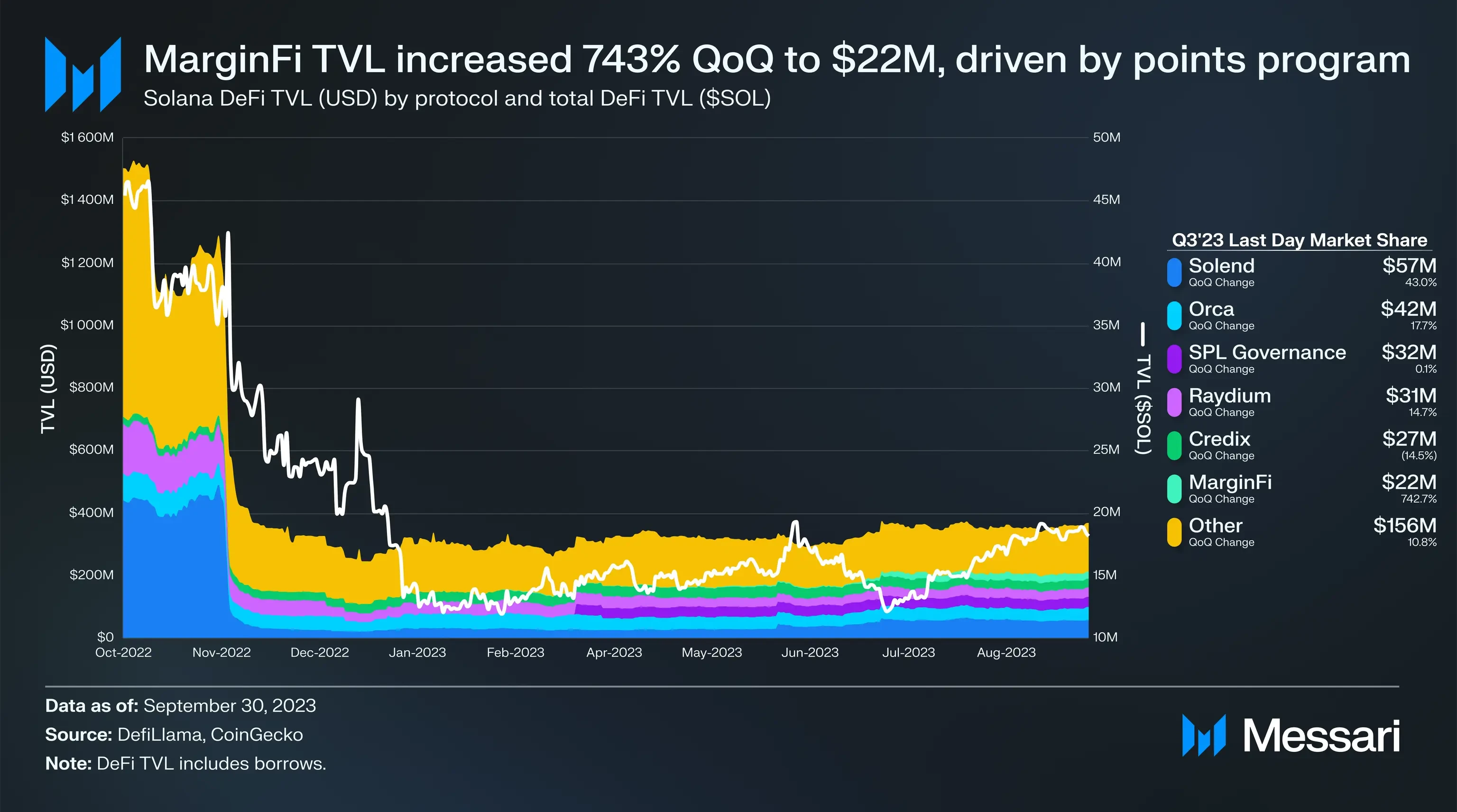
In the past few quarters, emerging Solana DeFi protocols have shown strong growth and have been classified as "Solana DeFi 2.0." This title represents the avoidance of the predatory and low-circulation tokenomics paradigm that was prevalent in the previous cycle. Additionally, most new protocols have not yet launched native tokens.
The lending protocol MarginFi is one of the leaders in this trend. On July 3, MarginFi introduced a point system, providing users with points for deposits, borrowing, and referring other users. Its total value locked (TVL) grew by 743% quarter-on-quarter to reach $22 million, making it the sixth-largest protocol on Solana. Subsequently, MarginFi launched its own staking token LST, which will be discussed in the "Staking" section below.
Perps Exchange Cypher also launched its point system in mid-July. Before suffering an attack worth about $1 million in early August, Cypher was one of the fastest-growing DeFi protocols on Solana. To help users recover their losses, Cypher announced an accelerated process for its CYPH initial distribution (IDO). In the initial distribution and airdrop, over 50% of CYPH tokens will be allocated to the community.
Solana's leading lending protocol Solend introduced a point program in early August. Solend did not use points for potential airdrops but associated them with its already launched token, SLND. The first season of Solend points will last for about three months, with a minimum reward pool of 100,000 SLND (valued at $54,000 as of September 30, 2023). Driven by the point system, Solend's TVL grew by 43% quarter-on-quarter to reach $57 million.
Other notable DeFi developments include:
Phoenix Release: The fully on-chain central limit order book Phoenix officially launched at the end of August, following its test version release in March. The August release came just a week after Phoenix's development team, Ellipsis Labs, announced the completion of a $3.3 million seed round of financing (led by Electric Capital). Since its release, the most popular trading pair on Phoenix, SOL/USDC, has had a daily average trading volume of over $3.4 million. Despite its TVL of $378,000 at the end of the quarter, much lower than other exchanges, Phoenix still had the highest trading volume in that trading pair.
Drift Growth: Among the top protocols on Solana, the perpetual contract exchange Drift was one of the fastest-growing protocols in Q3. At the end of the quarter, Drift's TVL reached $17.3 million, an 87% increase quarter-on-quarter and a 976% increase year-to-date. Drift underwent several notable upgrades throughout the quarter, including Drift liquidity providers, market maker incentives, and MetaMask Snap CONNECT. The CONNECT upgrade allows users to trade on Drift and perform cross-chain EVM to Solana transactions from MetaMask. It has been downloaded over 1,000 times.
Solflare Snap: The Solflare wallet introduced MetaMask Snap, with nearly 19,000 downloads. The Snap allows users to store Solana tokens and NFTs, bridge EVM to Solana through deBridge, and access Solflare-supported Solana apps. Solflare also launched the incentive program SolScout, offering a total of $100,000 in bonuses to users who complete daily ecosystem-related tasks through Solflare or its MetaMask Snap.
Jupiter V3: The swap aggregator Jupiter launched its V3 version at the end of July. It adopted the new routing algorithm Metis, providing better price discovery capabilities. Jupiter also introduced limit orders, dollar-cost averaging, and a bridge comparator. Jupiter's active addresses and trading volume data in Q3 positioned it as one of the top DeFi protocols on Solana.
Return of Maple: After ceasing development on Solana following the FTX crash, Maple Finance returned to Solana in early September, bringing its cash management solution. The product offers U.S. Treasury yields to DAOs and high-net-worth individuals and waives a 0.5% management fee (denominated in USDC). At the end of the quarter, Maple's TVL on Solana reached $4.2 million.
Circuit Launch and Financing: In August, Circuit launched the private beta of Circuit Vaults and announced a round of financing with participation from companies like Multicoin. Circuit collaborated with Drift, allowing users to deposit funds into the Supercharger insurance pool to access unbiased automated market maker strategies deployed on Drift.
And more developments, including tBTC integration, Credix's USDC accounts receivable pool, Kamino Creator Vaults (Kamino Lend was launched shortly after the end of the quarter), the release of Zeta V2, and the EUROe stablecoin.
Liquid Staking
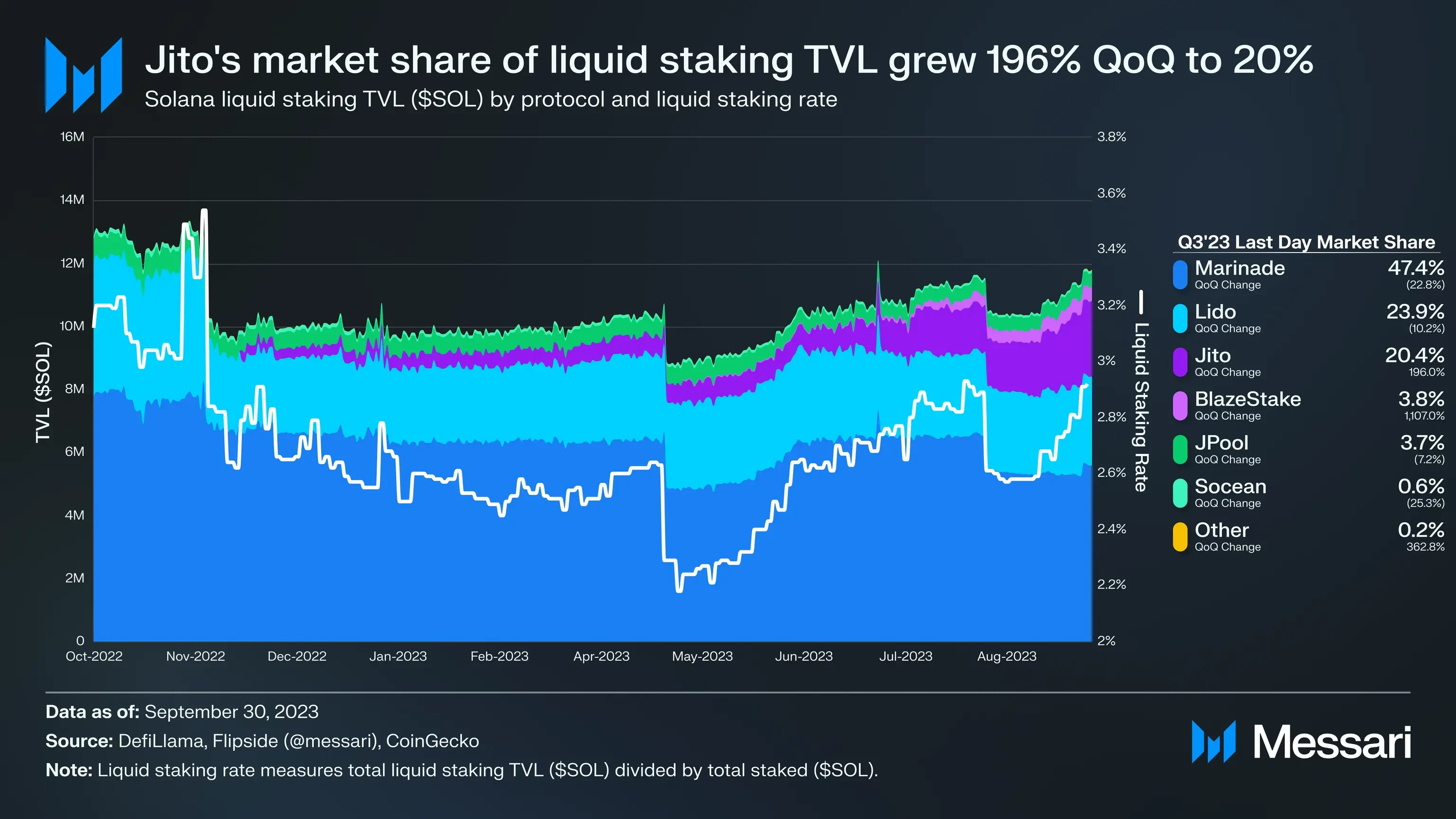
A significant portion of SOL in the Solana ecosystem is not actively participating due to being locked or in a liquid staking state. Liquid staking protocols have been working to stimulate more SOL participation through incentive programs to complement similar incentive trends in the DeFi ecosystem.
The liquid staking protocol Blaze has been hinting at an airdrop for bSOL holders since last year. In early August, it launched a point system, providing points to bSOL holders and offering bonus rewards for users using bSOL in DeFi protocols. Shortly after, Blaze launched its token BLZE and conducted an airdrop based on user points. As a representative of Solana DeFi 2.0, 64.5% of the BLZE supply will be distributed to users through initial airdrops and ongoing rewards. As of September 30, 2023, Blaze's TVL on SOL grew by 1234% quarter-on-quarter to reach 452,000 SOL (valued at $9.2 million).
Jito launched a referral program at the end of August and introduced its point system in mid-September. Similar to Blaze, Jito offers rewards to JitoSOL holders and increases their points in DeFi activities. Jito's TVL on SOL grew by 227% quarter-on-quarter to reach 2.4 million SOL (valued at $48.8 million as of September 30, 2023). At the end of the quarter, about 35% of JitoSOL was locked in the app, compared to 13% at the beginning of the quarter.
As with the DeFi ecosystem, the liquid staking pioneer Marinade introduced an incentive program in mid-September to match the growth of new protocols. Throughout the quarter, Marinade's TVL on SOL gradually declined but reversed and increased after September 20. Marinade also launched Marinade Native at the end of July, a native liquid staking product to complement Marinade's liquid staking. Marinade Native is an automated staking platform that routes staking to over 100 high-performing validators, without users having to pay performance fees or bear any smart contract risk.
As mentioned, MarginFi launched its own LST token, called LST, at the end of the quarter. LST routes staking to three validators operated by the MarginFi team. Unlike other liquid staking providers, MarginFi sacrifices a certain degree of decentralization for higher staking yields. These three validators use the JitoLabs client to pass MEV-enhanced rewards to LST holders and offer a 0% commission rate. The MarginFi team also hinted at the launch of stablecoins supported by LST.
After the proposal to terminate Lido's funding self-hold for Solana, which held nearly 24% of the liquid staking TVL market share, significant opportunities arose for other protocols to absorb its share.
Protocols like Super Stake and Sanctum further enhanced the liquid staking ecosystem. Super Stake was launched at the end of Q2 and increased LST yields through recursive borrowing strategies on Drift. In Q3, it added support for JitoSOL, joining mSOL. Both of Super Stake's insurance pools are currently full. Sanctum (formerly unstake.it) provides liquidity and stability for Solana's liquid staking and DeFi ecosystem, offering instant liquidity for locked SOL (bypassing the unlocking period) and a "safe harbor" SOL pool for LST-backed lending.
Consumer
NFTs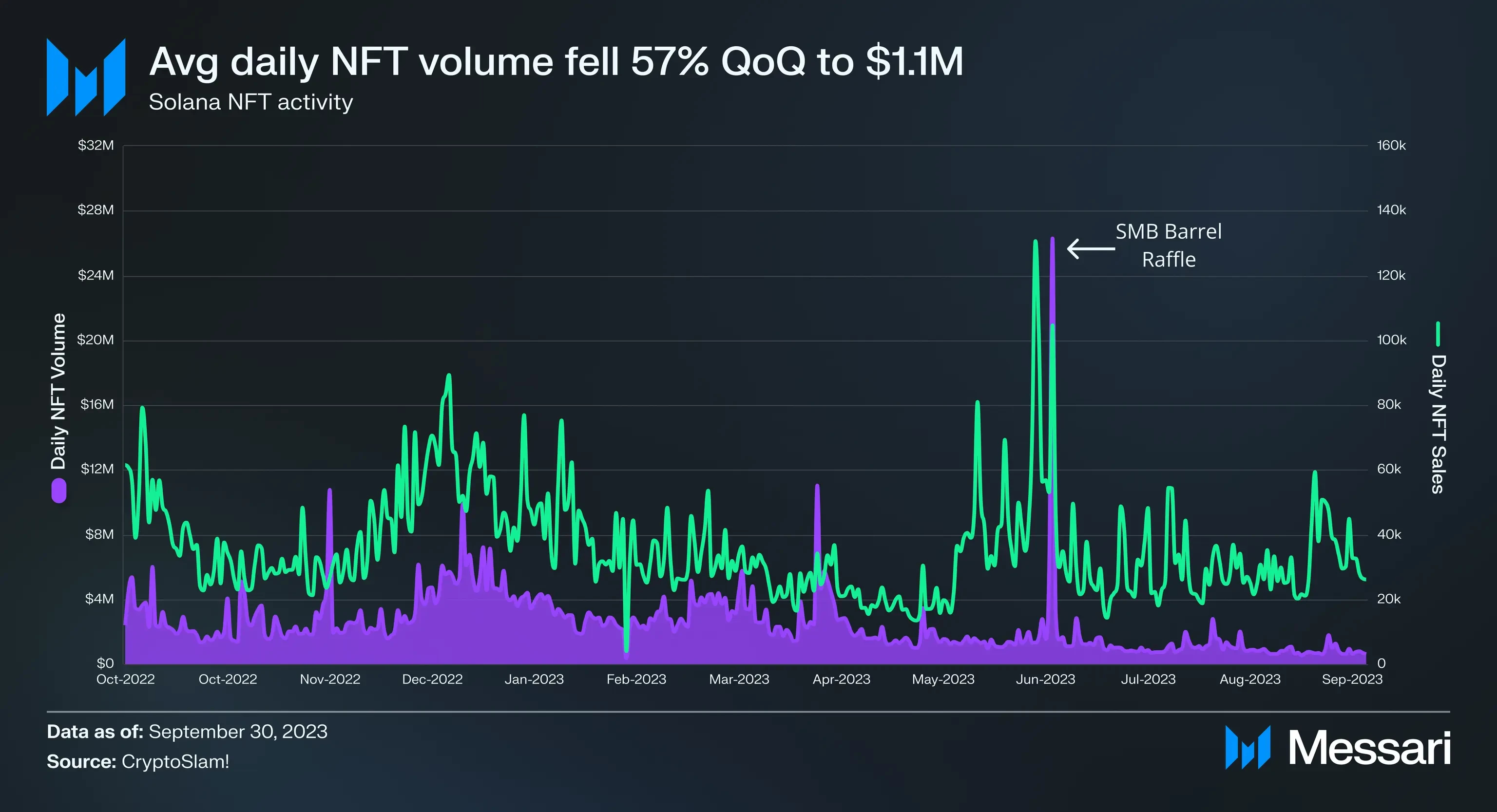 After the Solana Monkey Business lottery on the last day of Q2 led to a surge in NFT trading volume, the daily average NFT transaction volume decreased by 57% quarter-on-quarter to $1.1 million. Sales and the number of unique buyers also decreased year-on-year.
After the Solana Monkey Business lottery on the last day of Q2 led to a surge in NFT trading volume, the daily average NFT transaction volume decreased by 57% quarter-on-quarter to $1.1 million. Sales and the number of unique buyers also decreased year-on-year.
Key NFT developments in this quarter include:
Minting of Tensorians, Meegos, Reavers, Gates of BroHalla, and VTOPIANS, among others.
On September 23, the NFT series of the virtual horse racing game Photo Finish LIVE became the highest circulating market value series on Solana. This activity was likely due to the anticipation of its fourth virtual Kentucky Derby (officially licensed), which took place on September 23. However, by the end of the quarter, Mad Lads reclaimed the top position in market value.
Magic Eden regained the majority of market share by the end of the quarter, surpassing Tensor, whose market share peaked at over 74% in early August.
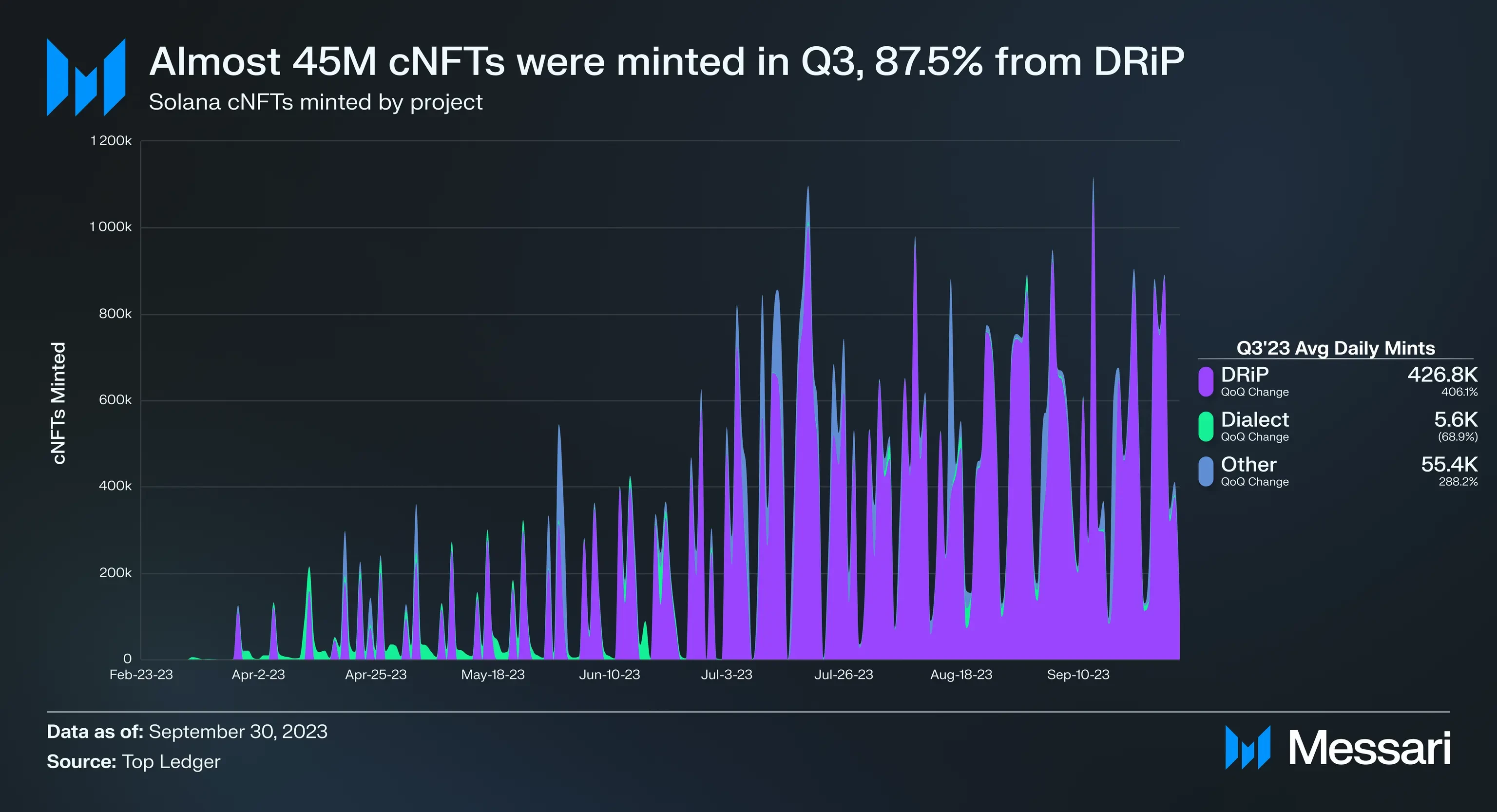
At the beginning of Q2, Solana introduced the state compression upgrade. This upgrade provided an economically efficient way to store data on-chain by hashing data into Merkle trees and publishing their root hashes on-chain. Its first significant use case was the compressed NFT (cNFTs) standard created by Metaplex: 1 million cNFTs were minted and stored in a compressed state, with costs ranging from 5.3 to 63.7 SOL, compared to 24,000 SOL if uncompressed.
Nearly 45 million cNFTs were minted in Q3, a 316% increase quarter-on-quarter. DRiP occupied the majority of market share at 87.5%. DRiP collaborated with artists for free NFT art minting, with a collection size much larger than the typical 10,000. In mid-August, DRiP announced the completion of a $3 million seed round of financing led by Placeholder.
Dialect is another major cNFT use case. Dialect is a Web3 messaging app that uses cNFTs as Dialect stickers. In early September, Dialect launched a web application.
As mentioned earlier, Tensor launched its Tensorian cNFT series in August. Users need to mint Tensorians through the Tensorian Shards mechanism, which will be rewarded as airdrops for the second season. Currently, the total trading volume of Tensorians and Tensorian Shards in Q3 is approximately $7 million.
Since its launch in May 2023, Tensor has been the primary market for cNFT trading. However, Magic Eden aimed to change this and added cNFT support in mid-September. Despite Magic Eden integrating cNFTs, Tensor retained almost 97.2% of the trading volume market share.
Another new use case for cNFTs emerged in early September, as developer kiryl introduced a multi-burn tool for cNFTs. The "Burning Man" task in September incentivized users to burn specific cNFTs for a chance to win prizes.
Gaming
In addition to Photo Finish LIVE, other notable gaming developments include:
Star Atlas SAGE Labs: Star Atlas launched a preview of its SAGE Labs open-world game at the end of September, offering users the chance to compete for a $1.2 million prize pool. As every action takes place on-chain, SAGE has become an important part of Solana's overall transaction volume.
Bonk SVB: On August 1, the meme coin Bonk launched Silicon Valley BONK (SVB), an on-chain lottery game where users compete to purchase keys, with the last key purchaser receiving a portion of the key purchase funds if they win.
The Heist Season 2: The popular idle game The Heist returned for Season 2 in mid-August, introducing new in-game currency and NFT series. In mid-September, the game added mobile support. Currently, The Heist leads in trading volume for all NFT series in Q3.
Social
One of the most significant events in the cryptocurrency space in Q3 was friend.tech, showcasing the potential for social applications to become breakthrough applications for cryptocurrency. Social applications on Solana include:
Access Protocol: Access is a creator revenue platform. Q3 saw the addition of 21 creators, bringing the total to 38. The number of subscribers doubled quarter-on-quarter, reaching 227,000.
Solarplex: The Web3 social media platform Solarplex opened its V2 version in mid-August, gaining initial attention.
SolLinked: In mid-August, Solana Labs co-founder Anatoly Yakovenko proposed a "LinkedIn version of friend.tech." Within a week, developer darksoulsfanlol established this platform. SolLinked allows users to set email and calendar accounts, set prices for email replies or calendar bookings, and accept payments using TipLink and USDC.
Friendzy: Friendzy is a more traditional branch of friend.tech, where keys can be traded before accounts are enabled. After its launch in mid-September, Friendzy's total locked value peaked at $190,000 on September 26, but decreased to $76,600 by the end of the quarter.
Hub3: Hub3 is another derivative of friend.tech, adding features such as group chats, discovery tools, and NFT whitelist services. It was launched on September 24, and activity gradually increased after the end of the quarter.
DePIN
Solana is becoming the center for DePIN applications, including Helium, Hivemapper, Teleport, Render (planned migration to Solana), and GenesysGo, among others.
Notable Q3 events include:
Helium: Helium, a decentralized wireless network, migrated to Solana in April 2023. In mid-August, Helium Mobile, utilizing the network, launched a $5 per month unlimited calling plan, initially limited to residents of Miami.
Hivemapper: Hivemapper aims to create a decentralized global map. At the end of August, it launched Hivemapper Bursts, providing additional HONEY rewards for mapping behaviors that draw hotspots as requested by customers. In Q3, Hivemapper mapped over 1 million unique miles of roads, totaling over 3.3 million miles.
Payments
Payments are another emerging application on Solana, achieving some significant milestones in Q3, especially with the integration of Visa and Shopify.
In early September, Visa announced the expansion of its USDC settlement pilot program to Solana. Visa's cryptocurrency team published an in-depth analysis on Solana, emphasizing their belief that Solana can help drive mainstream payment processes. Reasons include Solana's low and predictable fees achieved through a native fee market, parallel transaction processing, fast transaction confirmations, a large number of nodes, and multiple validator clients.
At the end of August, Solana Pay integrated with Shopify, allowing Shopify merchants to accept native USDC on Solana. Shopify accounts for approximately 10% of total e-commerce in the United States, and with standard fees (credit card) of 1.5%-2.5%, the entry of Solana Pay provides merchants with an almost free alternative for credit card choices.
Other notable payment developments include:
TipLink Gift Cards: TipLink allows users to send Solana tokens through links. In mid-September, it added the functionality to purchase gift cards using cryptocurrencies, providing a withdrawal method for users to receive cryptocurrencies through links.
Beam: Offramp Beam launched in mid-August, supporting Solana and several other networks. It subsequently released an SDK at the end of the month, enabling developers to easily integrate the solution into their applications.
CandyPay Mobile SDK: CandyPay enables applications to enable Solana token payments at checkout. In mid-August, it launched a mobile SDK.
Meso SDK Early Access: Meso provided early access to its SDK, allowing developers to integrate its flagship product into their applications.
Helio WooCommerce Partnership and Wallet: The multi-chain payment platform Helio partnered with WooCommerce in early September to power cryptocurrency payments on WordPress. A week later, it launched its self-hosted Solana wallet, allowing users to log in using email or Web2 social accounts.
Privacy
Solana has quietly developed more privacy protocols. In addition to the core zero-knowledge (ZK) upgrade in V1.16, developments in the third quarter include:
Light Protocol: Light Protocol is a zero-knowledge layer for building Private Solana Programs (PSPs) on Solana. Light Protocol uses the UTXO method to achieve privacy. It also uses private state compression, so the cost of private transactions is the same as regular Solana transactions. In early August, it released the first reference implementation based on PSPs.
Elusiv: Elusiv is another privacy layer that uses a shared pool approach. At the end of August, Elusiv launched private token swaps, using temporary keys to unlink users' public keys from their transactions. Elusiv swaps use Jupiter liquidity.
Developments
Resources and infrastructure established by Solana Labs, Helius, Ironforge, and other independent companies have driven ecosystem development.
Key releases in the third quarter include:
GameShift: Solana Labs released the GameShift API in mid-July, aiming to simplify Web3 game development.
Helius Pyre: In mid-July, Helius launched Helius Pyre, an open-source platform for learning Solana development through gamification. Helius also released Test Drive, a Postman-like open-source tool for testing RPC, providing documentation and examples.
Solana Curriculum: freeCodeCamp released a free developer course to help developers become familiar with Solana development by building 15 projects.
Synthetic Assets Platform Implementation: At the end of the quarter, Solana Labs released an open-source reference implementation of a synthetic assets platform.
Other developments: The Graph integration, Ironforge's Playground, four new Solana development courses, Ellipsis' Verified Builds tool, and Magicblock providing fuel-free RPC API for game development.
Growth
The Solana Foundation and independent organizations such as Lamport DAO and Superteam have furthered ecosystem development through grants, hackathons, accelerators, and other initiatives.
Key events in the third quarter include:
OPOS Hackathon: The Only Possible on Solana (OPOS) Hackathon, organized by Lamport DAO, took place in August. Over 600 participants competed in 25 categories for a $100,000 prize pool provided by 40 sponsors. It was held offline alongside mtndao's Hackers' House. The top prize winners currently are Onda Protocol ($10,000, Compression track) and Ned Finance ($10,000, Jupiter track).
Hyperdrive Hackathon: The Solana Foundation's online Hackathon began in early September. Over 5,000 developers will compete for up to $1 million in prizes and seed rounds across seven categories, running until October 15.
Hackers' House: The Solana 2023 Hackers' House Tour, sponsored by Jump Crypto, Circle, and the Solana Foundation, provided a place for developers to build, find partners, and learn from community members. This quarter's Hackers' House took place in Berlin, Bangalore, and Mumbai.
PlayGG: The Solana Foundation hosted the gaming festival PlayGG in mid-July. The event included demos, live streams, competitions, and workshops, showcasing dozens of Solana-based games.
Additional events and initiatives include the launch of the Quest platform Layer3, Solana Summer Festival, hosting of Solana developer workshops by HowTo, Solana University accelerator's Demo Day, and Monacode Hackathon.
Upcoming fourth-quarter events include Solana's annual Breakpoint conference, Hong Kong Hackers' House, Encode Club's Solana accelerator, Berlin Demo Day, and more.
In summary, especially considering the bear market, the Solana ecosystem has been active and rapidly developing in DeFi, liquidity staking, consumer, DePIN, and privacy protocols in the third quarter. Compressed NFTs (cNFTs) are becoming a popular use case for state compression, with the number of cNFTs minted in the third quarter growing by 316% to nearly 45 million. Free collectible distributor DRiP accounted for 87.5% of these mintings. Contrary to market trends, Solana's DeFi TVL increased by 32% in the third quarter, reaching $368 million. This growth was primarily driven by incentive programs launched by DeFi and liquidity staking protocols, including MarginFi, Jito, Cypher, and BlazeStake.
Solana's underlying technology has also garnered attention and adoption from external parties. Examples in the third quarter include Rune exploring a Solana fork of MakerDAO, L2 Eclipse going live, and Visa's payment integration on Solana. Additionally, Solana's technology continued to improve in the quarter. The V1.16 upgrade reduced memory requirements for validators, introduced features and capabilities required for confidential transfers, and improved support for zk proofs.
Finally, the market capitalization of SOL grew by 17% in the third quarter, reaching $8.4 billion. This growth occurred amidst concerns of FTX potentially liquidating its 57 million tokens, which received approval at a pretrial hearing in mid-September, although SOL held by FTX/Alameda is restricted by various unlocking schedules, with the average unlocking date in the fourth quarter of 2025. However, these locked tokens are still tradable over-the-counter. Despite this, Solana's network and ecosystem are poised to be stronger than when entering the bear market.
免责声明:本文章仅代表作者个人观点,不代表本平台的立场和观点。本文章仅供信息分享,不构成对任何人的任何投资建议。用户与作者之间的任何争议,与本平台无关。如网页中刊载的文章或图片涉及侵权,请提供相关的权利证明和身份证明发送邮件到support@aicoin.com,本平台相关工作人员将会进行核查。




